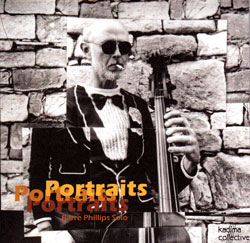
One of interesting things about Derek Bailey's live shows was the zen-like continuum he seemed to create between life inside and outside of the spotlight. His relaxed demeanor and habits like tuning and checking his equipment after taking the stage blurred the lines of when the "shows" began and ended.
Perhaps contrabassist Barre Phillips took to heart this inclination of his late playing partner (see, e.g., Figuring, Incus CD05), given the way this release begins. Recorded live in 2001 at the first Thomastik-Infeld "Bass Encounters," it starts with a voice addressing the audience and why they are there: "They all show up because of the big baby," says the voice. Is this the announcer? Is it Phillips? The listener wonders. Then the speaker gives a bass a few thwacks and asks "I mean, what can make sounds like that?" With that, Phillips launches into this magnificent set of solo bass pieces.
The release has plenty of the kind of chops one expects in such a setting and from a player with Phillips' vast experience. But while the pieces cover a lot of ground, Phillips' shifts of focus have a notable naturalness. Two-thirds of the way through "Right!", for example, there is a rhythmic section evocative of "Rite of Spring", but it transitions seamlessly into a quieter, more reflective segment — almost as if his hands merely began thinking about something else. Although the concert occurred at a bass showcase, there is little sense in this music of an itinerant salesman opening up his sample case.
This natural evolution in his music likely accrues to the fact that Phillips seems to allow himself to be pulled along by the sounds themselves. Deep into "The Dream", it is obvious that Phillips is not looking to establish his credibility as a virtuoso, but instead is fascinated by the sounds arising from his instrument. One can almost picture him staring intently as his fingers move, entranced by the moans, thumps, rasps, and rattles they are wringing from the bass.
Too, it is Phillips' engagement with the essence of his sounds that make it possible for him to pull of a rhythm-based piece like "Lifesafer". His riffs chug along in a sort of railway cadence, but the pulse becomes quite secondary to the subtleties of the gestures themselves. Phillips exploits the rhythm rather than using it as a way relax his concentration. As Phillips himself states in a snippet of patter with the audience, his philosophy of the bass is that it is essentially a "tuned drum."
Comments and Feedback:



More Recent Reviews, Articles, and Interviews @ The Squid's Ear...


|

